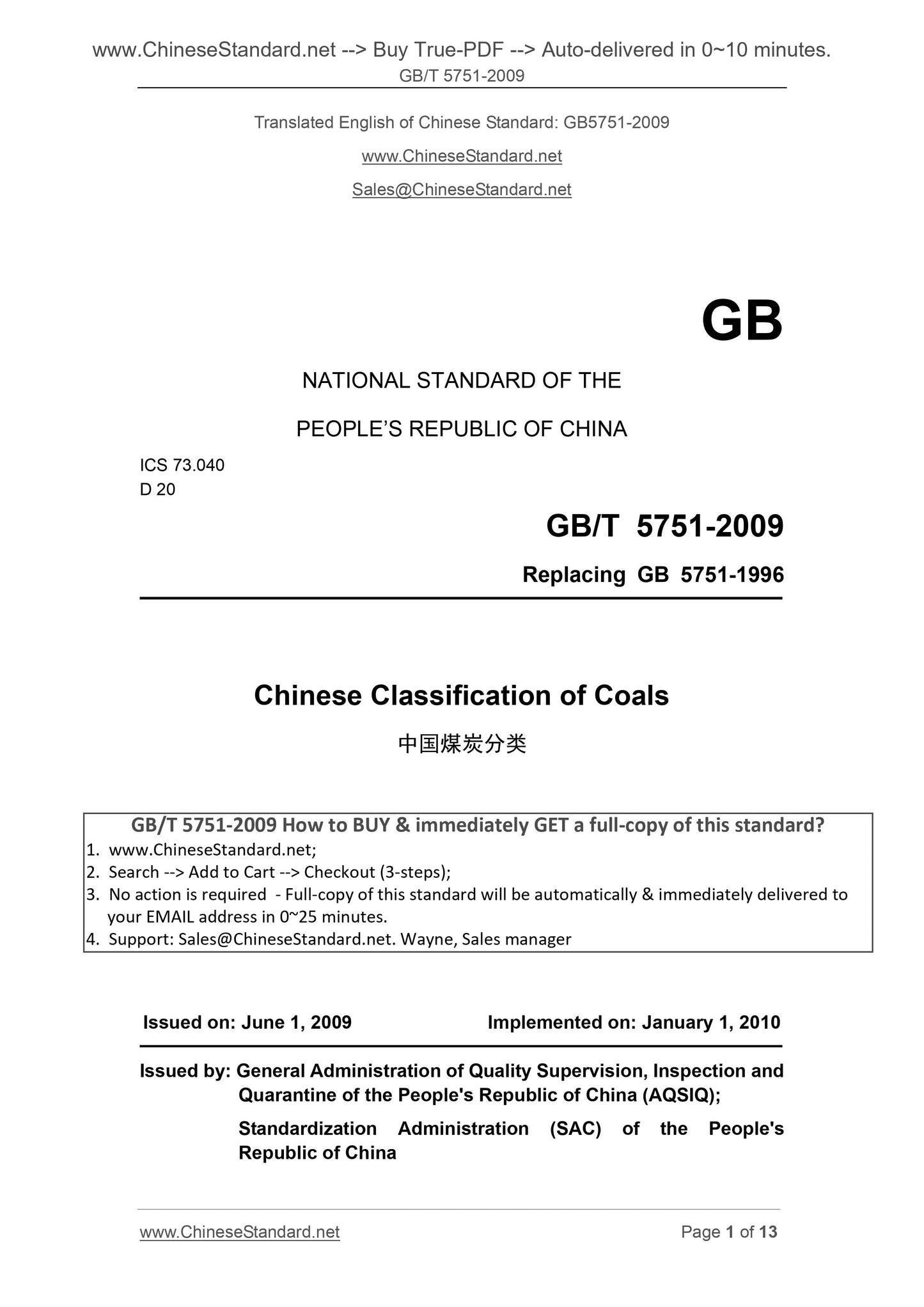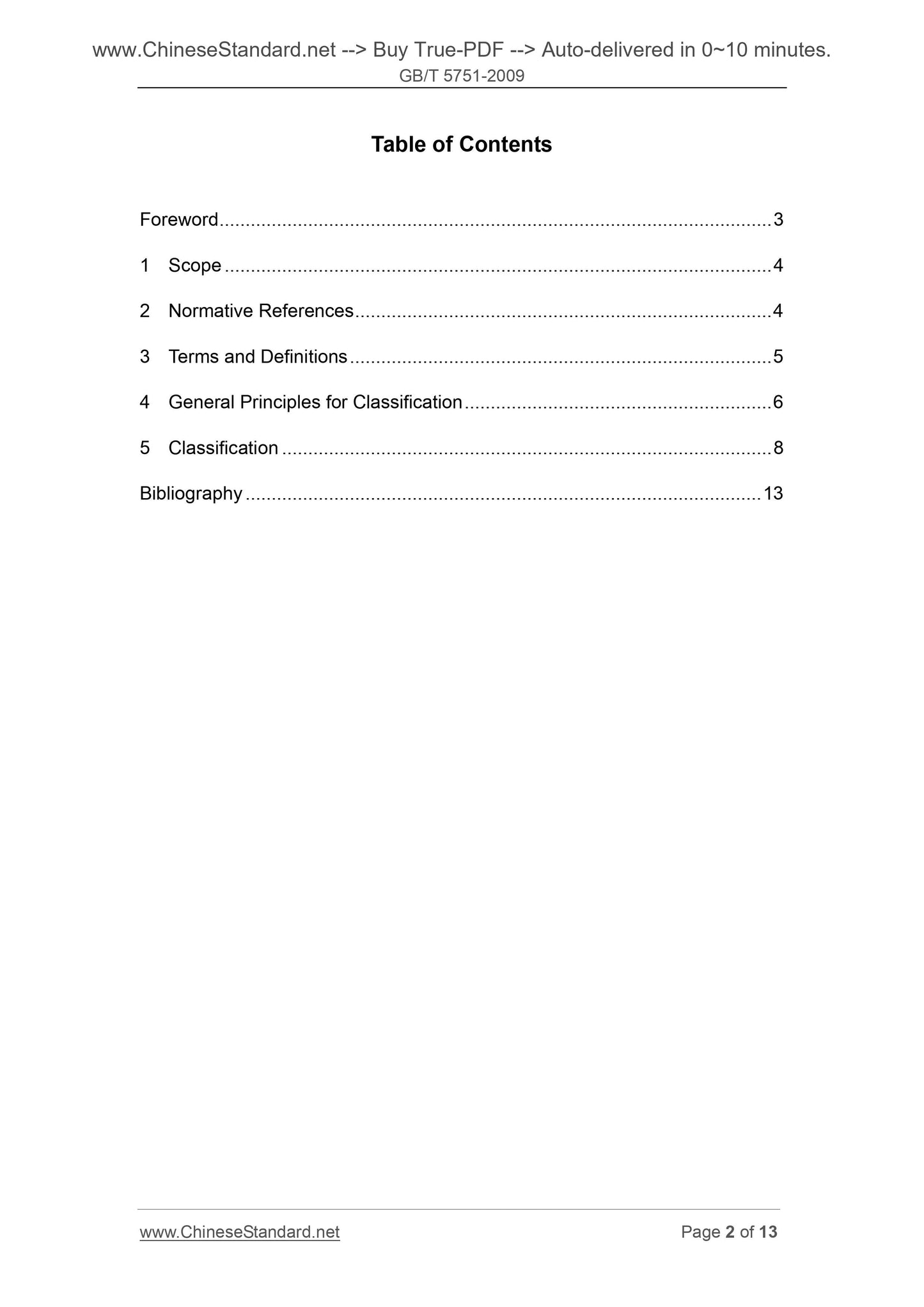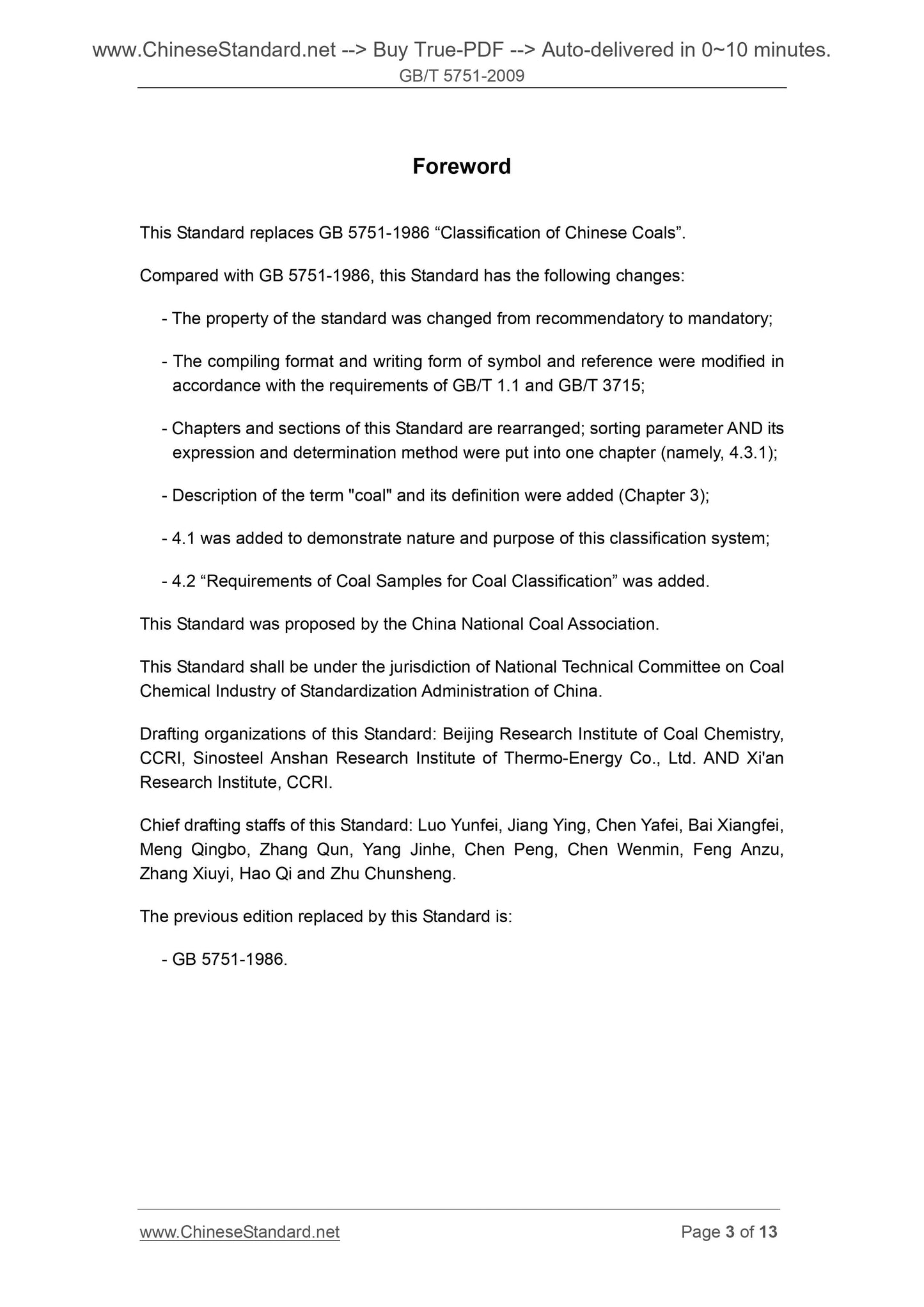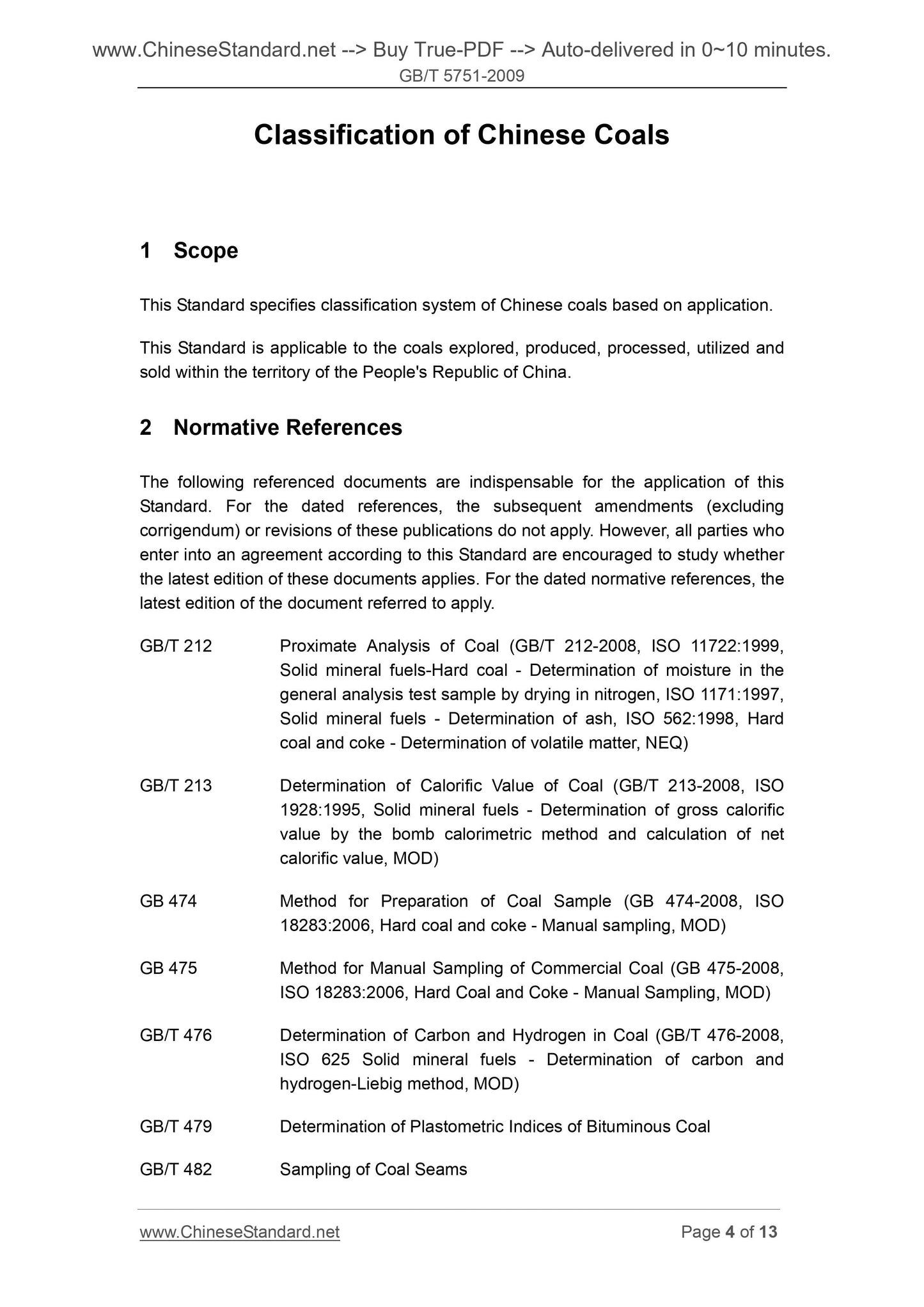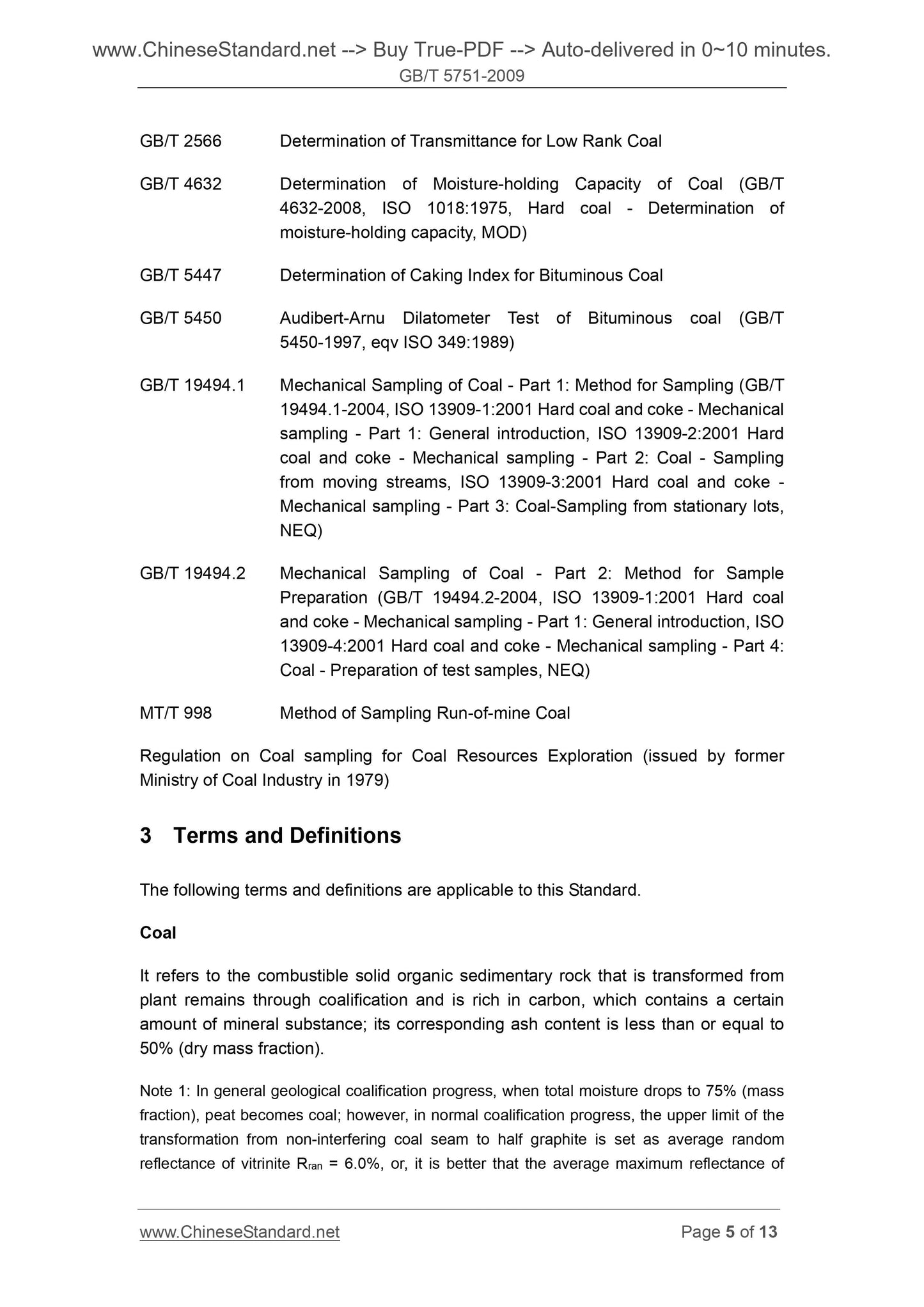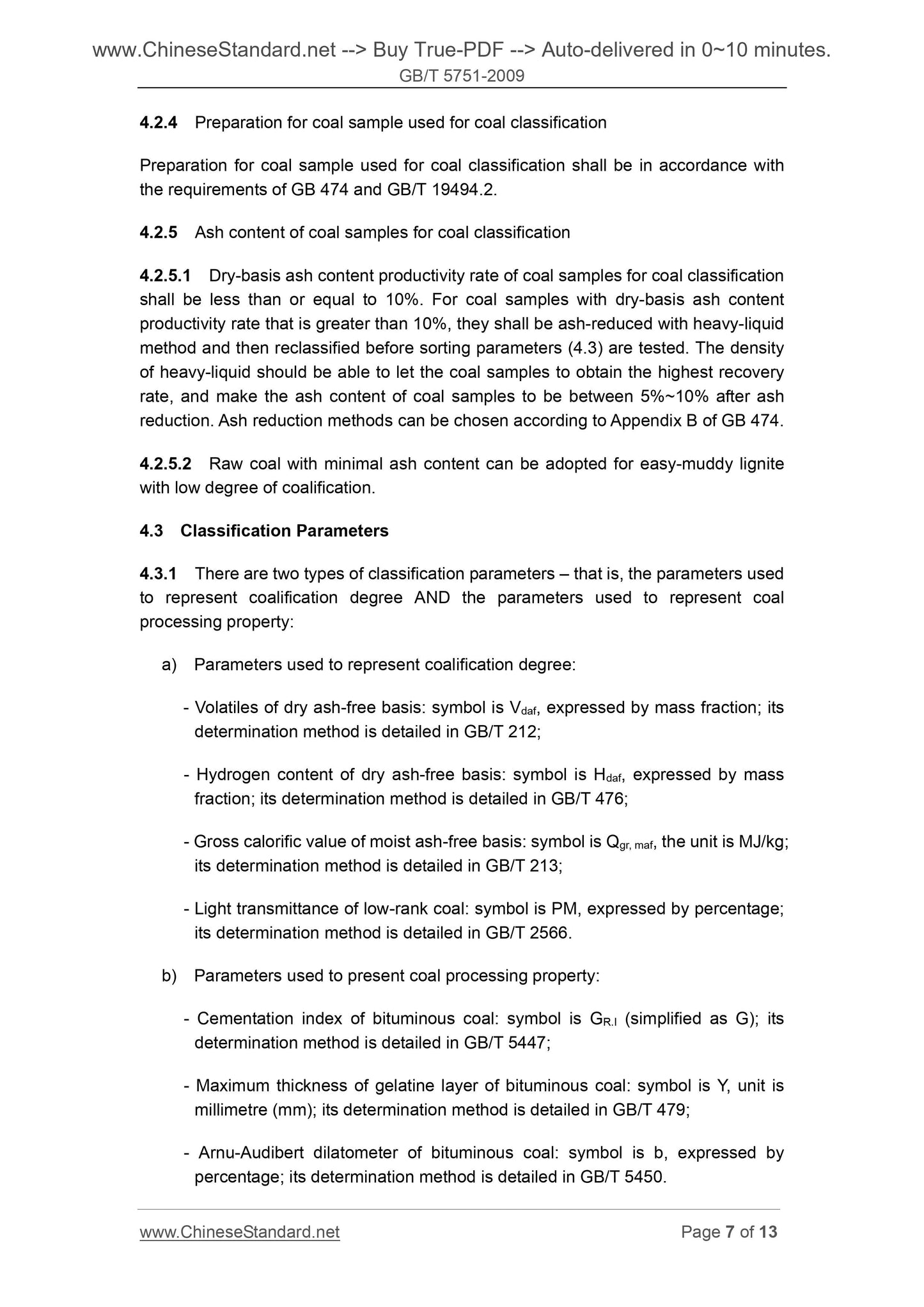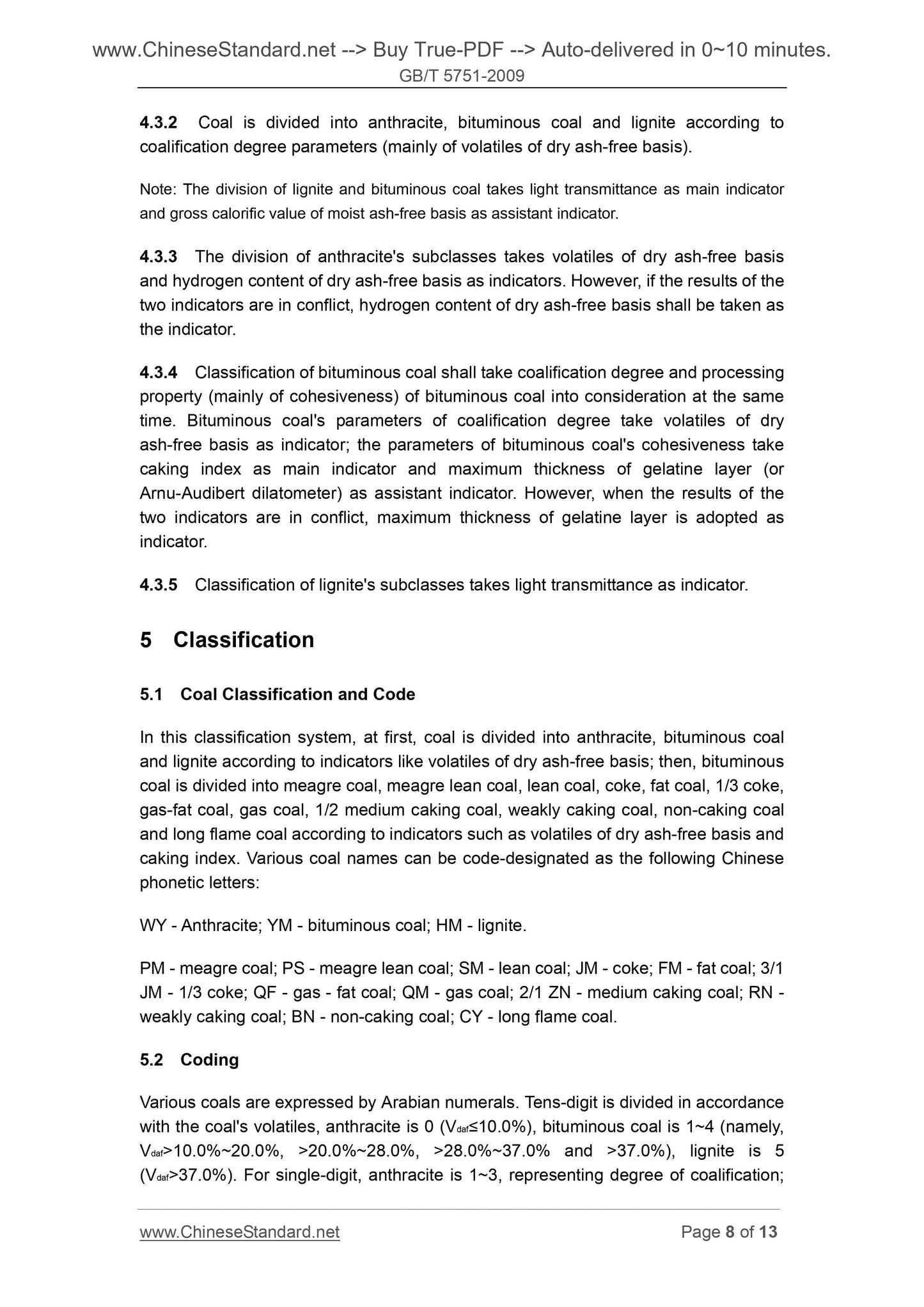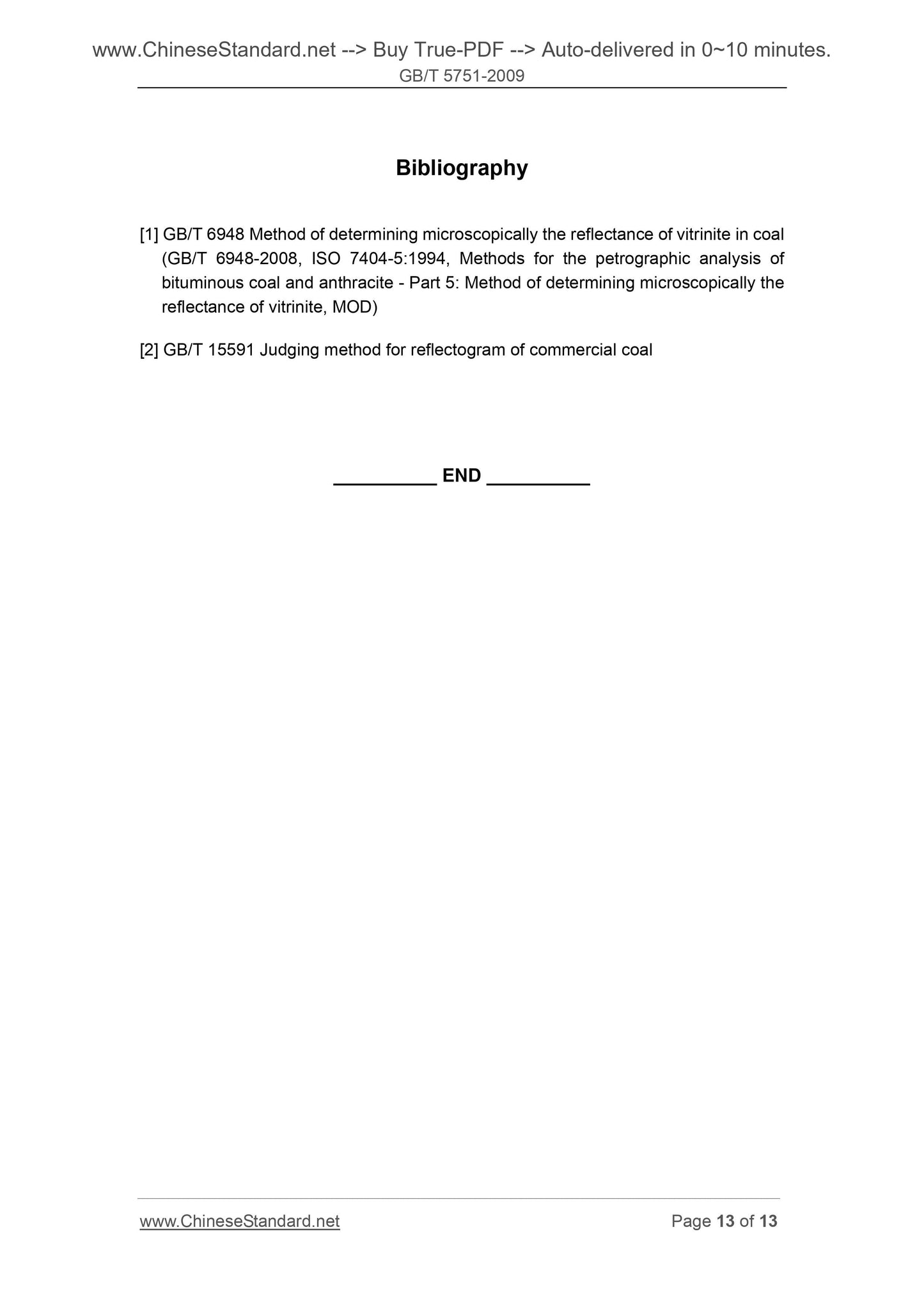1
/
of
8
PayPal, credit cards. Download editable-PDF and invoice in 1 second!
GB/T 5751-2009 English PDF (GBT5751-2009)
GB/T 5751-2009 English PDF (GBT5751-2009)
Regular price
$85.00 USD
Regular price
Sale price
$85.00 USD
Unit price
/
per
Shipping calculated at checkout.
Couldn't load pickup availability
Delivery: 3 seconds. Download true-PDF + Invoice.
Get QUOTATION in 1-minute: Click GB/T 5751-2009
Historical versions: GB/T 5751-2009
Preview True-PDF (Reload/Scroll if blank)
GB/T 5751-2009: Chinese coal classification
GB/T 5751-2009
GB
NATIONAL STANDARD OF THE
PEOPLE’S REPUBLIC OF CHINA
ICS 73.040
D 20
Replacing GB 5751-1996
Chinese Classification of Coals
ISSUED ON. JUNE 1, 2009
IMPLEMENTED ON. JANUARY 1, 2010
Issued by. General Administration of Quality Supervision, Inspection and
Quarantine of the People's Republic of China (AQSIQ);
Standardization Administration (SAC) of the People's
Republic of China
Table of Contents
Foreword ... 3
1 Scope ... 4
2 Normative References ... 4
3 Terms and Definitions ... 5
4 General Principles for Classification ... 6
5 Classification ... 8
Bibliography ... 13
Foreword
This Standard replaces GB 5751-1986 “Classification of Chinese Coals”.
Compared with GB 5751-1986, this Standard has the following changes.
- The property of the standard was changed from recommendatory to mandatory;
- The compiling format and writing form of symbol and reference were modified in
accordance with the requirements of GB/T 1.1 and GB/T 3715;
- Chapters and sections of this Standard are rearranged; sorting parameter AND its
expression and determination method were put into one chapter (namely, 4.3.1);
- Description of the term "coal" and its definition were added (Chapter 3);
- 4.1 was added to demonstrate nature and purpose of this classification system;
- 4.2 “Requirements of Coal Samples for Coal Classification” was added.
This Standard was proposed by the China National Coal Association.
This Standard shall be under the jurisdiction of National Technical Committee on Coal
Chemical Industry of Standardization Administration of China.
Drafting organizations of this Standard. Beijing Research Institute of Coal Chemistry,
CCRI, Sinosteel Anshan Research Institute of Thermo-Energy Co., Ltd. AND Xi'an
Research Institute, CCRI.
Chief drafting staffs of this Standard. Luo Yunfei, Jiang Ying, Chen Yafei, Bai Xiangfei,
Meng Qingbo, Zhang Qun, Yang Jinhe, Chen Peng, Chen Wenmin, Feng Anzu,
Zhang Xiuyi, Hao Qi and Zhu Chunsheng.
The previous edition replaced by this Standard is.
- GB 5751-1986.
Classification of Chinese Coals
1 Scope
This Standard specifies classification system of Chinese coals based on application.
This Standard is applicable to the coals explored, produced, processed, utilized and
sold within the territory of the People's Republic of China.
2 Normative References
The following referenced documents are indispensable for the application of this
Standard. For the dated references, the subsequent amendments (excluding
corrigendum) or revisions of these publications do not apply. However, all parties who
enter into an agreement according to this Standard are encouraged to study whether
the latest edition of these documents applies. For the dated normative references, the
latest edition of the document referred to apply.
GB/T 212 Proximate Analysis of Coal (GB/T 212-2008, ISO 11722.1999,
Solid mineral fuels-Hard coal - Determination of moisture in the
general analysis test sample by drying in nitrogen, ISO 1171.1997,
Solid mineral fuels - Determination of ash, ISO 562.1998, Hard
coal and coke - Determination of volatile matter, NEQ)
GB/T 213 Determination of Calorific Value of Coal (GB/T 213-2008, ISO
1928.1995, Solid mineral fuels - Determination of gross calorific
value by the bomb calorimetric method and calculation of net
calorific value, MOD)
GB 474 Method for Preparation of Coal Sample (GB 474-2008, ISO
18283.2006, Hard coal and coke - Manual sampling, MOD)
GB 475 Method for Manual Sampling of Commercial Coal (GB 475-2008,
ISO 18283.2006, Hard Coal and Coke - Manual Sampling, MOD)
GB/T 476 Determination of Carbon and Hydrogen in Coal (GB/T 476-2008,
ISO 625 Solid mineral fuels - Determination of carbon and
hydrogen-Liebig method, MOD)
GB/T 479 Determination of Plastometric Indices of Bituminous Coal
GB/T 482 Sampling of Coal Seams
GB/T 2566 Determination of Transmittance for Low Rank Coal
GB/T 4632 Determination of Moisture-holding Capacity of Coal (GB/T
4632-2008, ISO 1018.1975, Hard coal - Determination of
moisture-holding capacity, MOD)
GB/T 5447 Determination of Caking Index for Bituminous Coal
GB/T 5450 Audibert-Arnu Dilatometer Test of Bituminous coal (GB/T
5450-1997, eqv ISO 349.1989)
GB/T 19494.1 Mechanical Sampling of Coal - Part 1. Method for Sampling (GB/T
19494.1-2004, ISO 13909-1.2001 Hard coal and coke - Mechanical
sampling - Part 1. General introduction, ISO 13909-2.2001 Hard
coal and coke - Mechanical sampling - Part 2. Coal - Sampling
from moving streams, ISO 13909-3.2001 Hard coal and coke -
Mechanical sampling - Part 3. Coal-Sampling from stationary lots,
NEQ)
GB/T 19494.2 Mechanical Sampling of Coal - Part 2. Method for Sample
Preparation (GB/T 19494.2-2004, ISO 13909-1.2001 Hard coal
and coke - Mechanical sampling - Part 1. General introduction, ISO
13909-4.2001 Hard coal and coke - Mechanical sampling - Part 4.
Coal - Preparation of test samples, NEQ)
MT/T 998 Method of Sampling Run-of-mine Coal
Regulation on Coal sampling for Coal Resources Exploration (issued by former
Ministry of Coal Industry in 1979)
3 Terms and Definitions
The following terms and definitions are applicable to this Standard.
Coal
It refers to the combustible solid organic sedimentary rock that is transformed from
plant remains through coalification and is rich in carbon, which contains a certain
amount of mineral substance; its corresponding ash content is less than or equal to
50% (dry mass fraction).
Note 1. In general geological coalification progress, when total moisture drops to 75% (mass
fraction), peat becomes coal; however, in normal coalification progress, the upper limit of the
transformation from non-interfering coal seam to half graphite is set as average random
reflectance of vitrinite Rran = 6.0%, or, it is better that the average maximum reflectance of
4.2.4 Preparation for coal sample used for coal classification
Preparation for coal sample used for coal classification shall be in accordance with
the requirements of GB 474 and GB/T 19494.2.
4.2.5 Ash content of coal samples for coal classification
4.2.5.1 Dry-basis ash content productivity rate of coal samples for coal classification
shall be less than or equal to 10%. For coal samples with dry-basis ash content
productivity rate that is greater than 10%, they shall be ash-reduced with heavy-liquid
method and then reclassified before sorting parameters (4.3) are tested. The density
of heavy-liquid should be able to let the coal samples to obtain the highest recovery
rate, and make the ash content of coal samples to be between 5%~10% after ash
reduction. Ash reduction methods can be chosen according to Appendix B of GB 474.
4.2.5.2 Raw coal with minimal ash content can be adopted for easy-muddy lignite
with low degree of coalification.
4.3 Classification Parameters
4.3.1 There are two types of classification parameters – that is, the parameters used
to represent coalification degree AND the parameters used to represent coal
processing property.
a) Parameters used to represent coalification degree.
- Volatiles of dry ash-free basis. symbol is Vdaf, expressed by mass fraction; its
determination method is detailed in GB/T 212;
- Hydrogen content of dry ash-free basis. symbol is Hdaf, expressed by mass
fraction; its determination method is detailed in GB/T 476;
- Gross calorific value of moist ash-free basis. symbol is Qgr, maf, the unit is MJ...
Get QUOTATION in 1-minute: Click GB/T 5751-2009
Historical versions: GB/T 5751-2009
Preview True-PDF (Reload/Scroll if blank)
GB/T 5751-2009: Chinese coal classification
GB/T 5751-2009
GB
NATIONAL STANDARD OF THE
PEOPLE’S REPUBLIC OF CHINA
ICS 73.040
D 20
Replacing GB 5751-1996
Chinese Classification of Coals
ISSUED ON. JUNE 1, 2009
IMPLEMENTED ON. JANUARY 1, 2010
Issued by. General Administration of Quality Supervision, Inspection and
Quarantine of the People's Republic of China (AQSIQ);
Standardization Administration (SAC) of the People's
Republic of China
Table of Contents
Foreword ... 3
1 Scope ... 4
2 Normative References ... 4
3 Terms and Definitions ... 5
4 General Principles for Classification ... 6
5 Classification ... 8
Bibliography ... 13
Foreword
This Standard replaces GB 5751-1986 “Classification of Chinese Coals”.
Compared with GB 5751-1986, this Standard has the following changes.
- The property of the standard was changed from recommendatory to mandatory;
- The compiling format and writing form of symbol and reference were modified in
accordance with the requirements of GB/T 1.1 and GB/T 3715;
- Chapters and sections of this Standard are rearranged; sorting parameter AND its
expression and determination method were put into one chapter (namely, 4.3.1);
- Description of the term "coal" and its definition were added (Chapter 3);
- 4.1 was added to demonstrate nature and purpose of this classification system;
- 4.2 “Requirements of Coal Samples for Coal Classification” was added.
This Standard was proposed by the China National Coal Association.
This Standard shall be under the jurisdiction of National Technical Committee on Coal
Chemical Industry of Standardization Administration of China.
Drafting organizations of this Standard. Beijing Research Institute of Coal Chemistry,
CCRI, Sinosteel Anshan Research Institute of Thermo-Energy Co., Ltd. AND Xi'an
Research Institute, CCRI.
Chief drafting staffs of this Standard. Luo Yunfei, Jiang Ying, Chen Yafei, Bai Xiangfei,
Meng Qingbo, Zhang Qun, Yang Jinhe, Chen Peng, Chen Wenmin, Feng Anzu,
Zhang Xiuyi, Hao Qi and Zhu Chunsheng.
The previous edition replaced by this Standard is.
- GB 5751-1986.
Classification of Chinese Coals
1 Scope
This Standard specifies classification system of Chinese coals based on application.
This Standard is applicable to the coals explored, produced, processed, utilized and
sold within the territory of the People's Republic of China.
2 Normative References
The following referenced documents are indispensable for the application of this
Standard. For the dated references, the subsequent amendments (excluding
corrigendum) or revisions of these publications do not apply. However, all parties who
enter into an agreement according to this Standard are encouraged to study whether
the latest edition of these documents applies. For the dated normative references, the
latest edition of the document referred to apply.
GB/T 212 Proximate Analysis of Coal (GB/T 212-2008, ISO 11722.1999,
Solid mineral fuels-Hard coal - Determination of moisture in the
general analysis test sample by drying in nitrogen, ISO 1171.1997,
Solid mineral fuels - Determination of ash, ISO 562.1998, Hard
coal and coke - Determination of volatile matter, NEQ)
GB/T 213 Determination of Calorific Value of Coal (GB/T 213-2008, ISO
1928.1995, Solid mineral fuels - Determination of gross calorific
value by the bomb calorimetric method and calculation of net
calorific value, MOD)
GB 474 Method for Preparation of Coal Sample (GB 474-2008, ISO
18283.2006, Hard coal and coke - Manual sampling, MOD)
GB 475 Method for Manual Sampling of Commercial Coal (GB 475-2008,
ISO 18283.2006, Hard Coal and Coke - Manual Sampling, MOD)
GB/T 476 Determination of Carbon and Hydrogen in Coal (GB/T 476-2008,
ISO 625 Solid mineral fuels - Determination of carbon and
hydrogen-Liebig method, MOD)
GB/T 479 Determination of Plastometric Indices of Bituminous Coal
GB/T 482 Sampling of Coal Seams
GB/T 2566 Determination of Transmittance for Low Rank Coal
GB/T 4632 Determination of Moisture-holding Capacity of Coal (GB/T
4632-2008, ISO 1018.1975, Hard coal - Determination of
moisture-holding capacity, MOD)
GB/T 5447 Determination of Caking Index for Bituminous Coal
GB/T 5450 Audibert-Arnu Dilatometer Test of Bituminous coal (GB/T
5450-1997, eqv ISO 349.1989)
GB/T 19494.1 Mechanical Sampling of Coal - Part 1. Method for Sampling (GB/T
19494.1-2004, ISO 13909-1.2001 Hard coal and coke - Mechanical
sampling - Part 1. General introduction, ISO 13909-2.2001 Hard
coal and coke - Mechanical sampling - Part 2. Coal - Sampling
from moving streams, ISO 13909-3.2001 Hard coal and coke -
Mechanical sampling - Part 3. Coal-Sampling from stationary lots,
NEQ)
GB/T 19494.2 Mechanical Sampling of Coal - Part 2. Method for Sample
Preparation (GB/T 19494.2-2004, ISO 13909-1.2001 Hard coal
and coke - Mechanical sampling - Part 1. General introduction, ISO
13909-4.2001 Hard coal and coke - Mechanical sampling - Part 4.
Coal - Preparation of test samples, NEQ)
MT/T 998 Method of Sampling Run-of-mine Coal
Regulation on Coal sampling for Coal Resources Exploration (issued by former
Ministry of Coal Industry in 1979)
3 Terms and Definitions
The following terms and definitions are applicable to this Standard.
Coal
It refers to the combustible solid organic sedimentary rock that is transformed from
plant remains through coalification and is rich in carbon, which contains a certain
amount of mineral substance; its corresponding ash content is less than or equal to
50% (dry mass fraction).
Note 1. In general geological coalification progress, when total moisture drops to 75% (mass
fraction), peat becomes coal; however, in normal coalification progress, the upper limit of the
transformation from non-interfering coal seam to half graphite is set as average random
reflectance of vitrinite Rran = 6.0%, or, it is better that the average maximum reflectance of
4.2.4 Preparation for coal sample used for coal classification
Preparation for coal sample used for coal classification shall be in accordance with
the requirements of GB 474 and GB/T 19494.2.
4.2.5 Ash content of coal samples for coal classification
4.2.5.1 Dry-basis ash content productivity rate of coal samples for coal classification
shall be less than or equal to 10%. For coal samples with dry-basis ash content
productivity rate that is greater than 10%, they shall be ash-reduced with heavy-liquid
method and then reclassified before sorting parameters (4.3) are tested. The density
of heavy-liquid should be able to let the coal samples to obtain the highest recovery
rate, and make the ash content of coal samples to be between 5%~10% after ash
reduction. Ash reduction methods can be chosen according to Appendix B of GB 474.
4.2.5.2 Raw coal with minimal ash content can be adopted for easy-muddy lignite
with low degree of coalification.
4.3 Classification Parameters
4.3.1 There are two types of classification parameters – that is, the parameters used
to represent coalification degree AND the parameters used to represent coal
processing property.
a) Parameters used to represent coalification degree.
- Volatiles of dry ash-free basis. symbol is Vdaf, expressed by mass fraction; its
determination method is detailed in GB/T 212;
- Hydrogen content of dry ash-free basis. symbol is Hdaf, expressed by mass
fraction; its determination method is detailed in GB/T 476;
- Gross calorific value of moist ash-free basis. symbol is Qgr, maf, the unit is MJ...
Share
